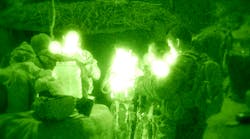Everyone is fascinated with Special Operations Forces — the high-tech equipment, silent weapons, dangerous scenarios, and thrilling missions. Any military force can have great weapons and physical fitness and remain unsuccessful. What makes SOF soldiers successful is the teamwork, planning, and leadership skills that augmented those other assets.
SOF soldiers pride themselves on their high levels of planning and performance, and their simultaneous dedication to mission accomplishment and team members. Importantly, all SOF soldiers are zealous to learn, improve, and teach other team members. Through heavy participation in creating, improving, and approving final mission plans, they are highly engaged in mission success.
Adopting SOF planning and leadership tactics for your organization will drive employee performance, innovation, team work, and engagement.
Use Backward Planning. Backward planning is a core military planning sequence that starts at a project’s completion and works back to the present. Backward planning aligns resources, different organizations, and activities, and synchronizes everything to ensure the entire organization works together. For example, if my project is to supply materials to help build a bridge, my project plan starts when the bridge is open and works backward from that time to the present.
The value of this simple approach is that it requires the team to incorporate all the critical details necessary to make a plan succeed.
War Games Perfect Good Plans. “War-gaming” tests and adapts battle plans against the expected (and unexpected) actions and reactions of the enemy. As a battle plan is developed, military planners have a separate team role-play the “enemy” to ensure the plan is challenged against the full range of possibilities.
Once the war game is complete, the initial plan is updated and re-written to mitigate all the predicted enemy actions, to ensure that the plan will succeed — and it works every time, from a hiring process to a new product launch.
Rehearsal Makes Good Plans Great. Any type of innovation needs constant testing and improving, followed by reevaluation. This ability to perform, test, and improve is a critical part of why that SOF soldiers excel. Setting up a machine gun quickly and under all weather conditions takes practice. Military convoy teams constantly rehearse how to react to an enemy attack, treat an injured team member, or recover a stuck vehicle.
Knowing how to practice, improve, and practice again at a fundamental level is critical to innovation and plan success.
Implement Lessons Learned. SOF uses the U.S. Army’s After-Action Review process to review, capture, and learn from mistakes. AAR helps the organization and individuals understand what happened, what worked, what did not work — and why.
Once the team understands and agrees on what needs to be fixed, it acts together to discuss, experiment, find, and agree upon a solution. AAR is used daily and in the same manner for all unit sizes, from three to five people up to thousands of people. A well-run AAR creates engagement among participants because it asks and listens to feedback from all team members, regardless of rank, position, or experience.
Create Backup Plans. Another Special Operations planning process is the P-A-C-E plan. P-A-C-E —Primary, Alternate, Contingency, and Emergency — is used to create four independent and effective ways to carry out critical battlefield processes, such as casualty evacuation, ammunition resupply, or leaving an objective area.
With P-A-C-E, Special Operations ensure success because they plan and expect problems and find ways to surmount obstacles to ensure the mission is a success even if the first three plans fail. Success is not an accident, and it’s never guaranteed.
An innovation process needs leaders and team members. On great teams that foster innovation, a team member must be able to perform as both a leader and as a follower. The ability to know when to lead, gather information, and take initiative is just as important as knowing when to support a leader, help the leader succeed, and help the leader be successful. A vast majority of people think of themselves as either a leader or a follower. SOF members know how to be both, and their ability to alternate between leader and follower makes a SOF soldiers a dual asset, because they can contribute 100% in either capacity.
SOF teams succeed through hard work, rehearsal, extensive training, extensive planning, thorough use of intelligence, and technology. However, the greatest asset to any team is the individual skill sets working together to enhance, train, teach, and lead the team to ever-higher levels of performance.
Chad Storlie is a retired U.S. Army Special Forces officer, an Iraq combat veteran, and has 15 years teaching experience as an adjunct Professor of Marketing. He is a mid-level B2B marketing executive and a widely published author on leadership, business, data, military and technology topics.
Contact him at [email protected], or visit www.CombatToCorporate.com









